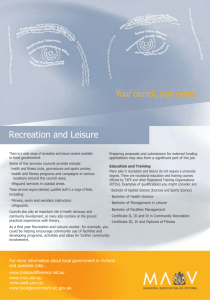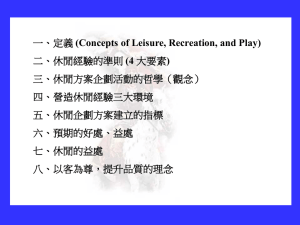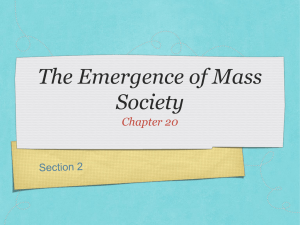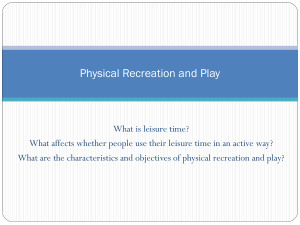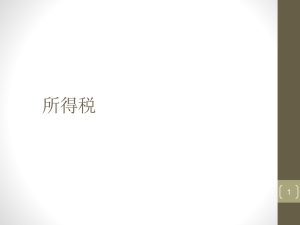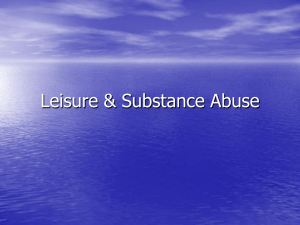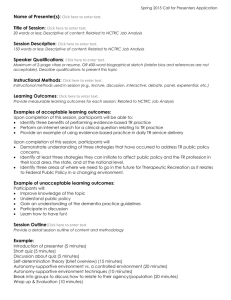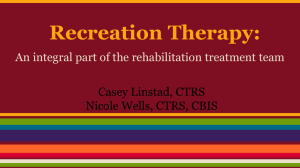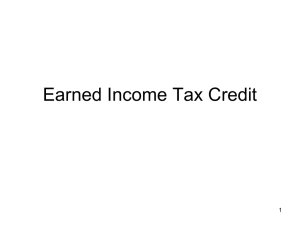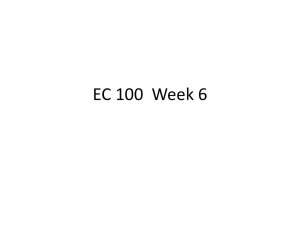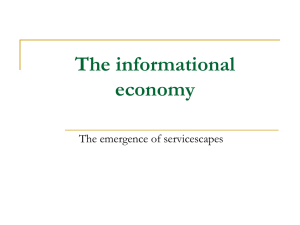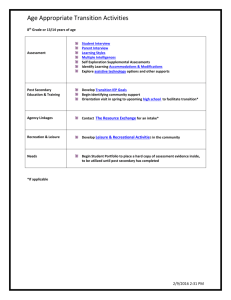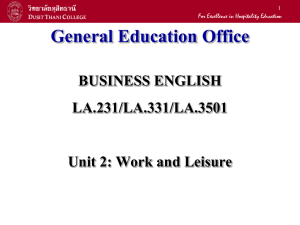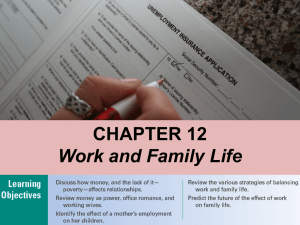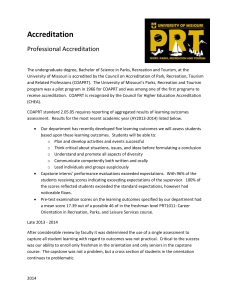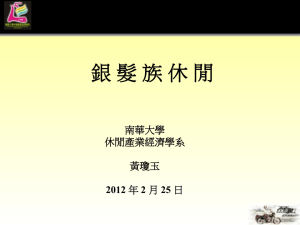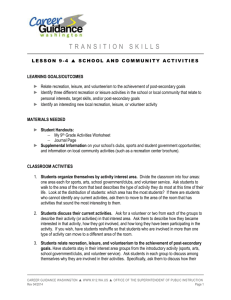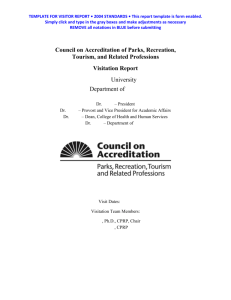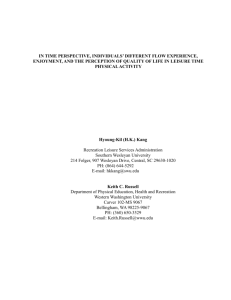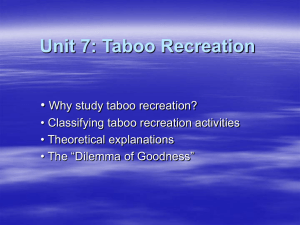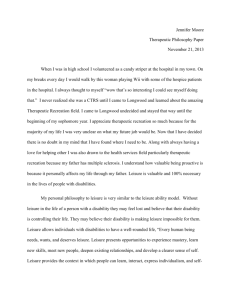Therapeutic Recreation Practice Models
advertisement
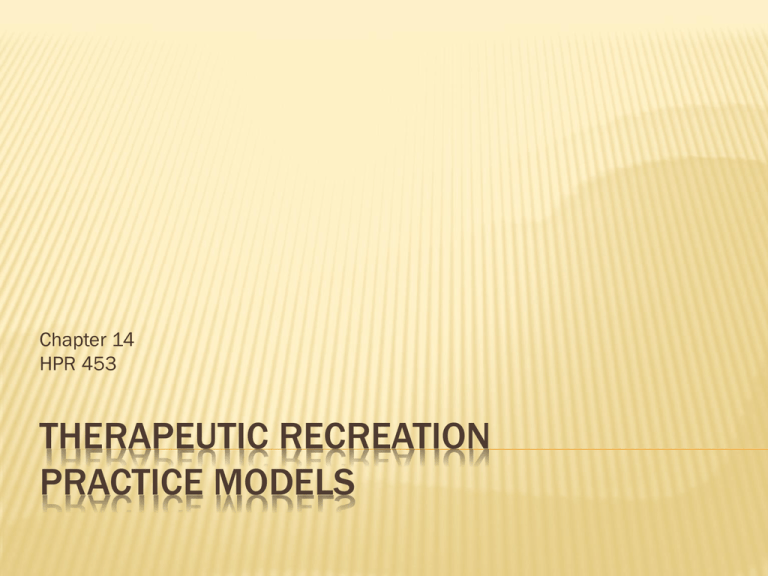
Chapter 14 HPR 453 THERAPEUTIC RECREATION PRACTICE MODELS QUESTIONS YOU ARE AND WILL BE ASKED… What is TR? What are anticipated outcomes of TR? What strategies or interventions are used to bring about the outcomes? What is the profession’s scope of practice? What is unique about TR? How does TR fit into health and human service delivery systems? PRACTICE MODELS ARE PHILOSOPHIES They guide therapists Foundation for public policy Foundation for research Foundation for further development of the profession 2 Types of Practice Models Content Models Practice Models CONTENT AND PROCESS MODELS Content Models identify the “what” or substance of TR services Process models identify the “how” or means (procedures for design and delivery) There are numerous Models and selection should be made carefully – It guides everything done in practice to produce outcomes for clients DIFFERING PHILOSOPHIES RESULT IN DIFFERENT CONCEPTS OF LEISURE End vs. Means to End Leisure Orientation – Outcomes related to leisure behavior body of knowledge Therapy Orientation – Outcomes related to change or improvement in functional behaviors (medical, psychiatric, psychological, and human development) body of knowledge Currently TR delivered primarily in healthcare arena Models must be congruent with medical model, nonmedical models, public policy, professional association, accrediting bodies (JC and CARF), societal trends Limitations – Models are static diagrams – practice is multifaceted MODELS 1978 – Gunn and Peterson - TR Service Model (Leisurability Model) Late 70s & early 80s – Philosophical views continued to be discussed (Recreation vs. Treatment vs. both vs. Leisurability) Mid to late 80s shift from leisure to healthcare models Therapy oriented (means) vs. Leisure oriented (outcomes) SHIFT FROM MEDICAL MODEL TO WELLNESS Pew Health Commission (1995) Paradigm shift from illness, cures, and separation of mind and body to… Holistic Health (mind and body), wellness and prevention WHO defines health as …”a state of complete physical, mental, and social well-being and not merely the absence of disease or infirmity.” Coding Systems ICD-10 is mainly used to classify causes of death ICF classifies health – based on psychosocial model ICF mainstreams the experience of disability and classifies it as one dimension of a person Treatment has shifted from “process” to “outcomes” HEALTHY PEOPLE 2010 USDHHS, 2000 2 GOALS FOR NATION’S HEALTH AGENDA INCREASE QUALITY AND YEARS OF HEALTHY LIFE ELIMINATE HEALTH DISPARITIES “Quality of life reflects a general sense of happiness and satisfaction with our lives and environment. General quality of life encompasses all aspects of life including health, recreation, culture, rights, values, beliefs, and aspirations, and the condition of a life which contains these elements” TR PRACTICE MODELS Leisure Outcome Models Leisurability Model – anticipated outcome is a satisfying leisure lifestyle – independent functioning of an individual in leisure experiences and activities of their choice – This leads to improved health, quality of life and well-being Supposes that TRSs assist person’s with illness and/or disabilities to overcome leisure barriers Continuum Model HEALTH AND WELLNESS OUTCOMES MODELS Health Protection/Health Promotion Model (Austin, 1991 and continually updated) The goal of TR is for clients to achieve the highest level of health The purpose of TR is identified as enabling a client to recover from a threat to health (health protection) and to achieve optimal health (health promotion) Prescriptive activity, recreation and leisure TR SERVICE DELIVERY MODEL AND TR OUTCOME MODEL (CARTER, VAN ANDEL AND ROBB, 1995) Meant to be used together – Outcome Model is an extension of TR Service Delivery Model The purpose of TR is the maintenance or improvement of the health status, quality of life an/or functional capacities of clients through the use of specially designed recreation or experiential activities and processes” Overall outcome is QoL – Health status is intermediate outcome TR OUTCOME MODEL Primary Components Functional capacities/potential Health status/wellness Quality of life Leisure function represents a complex interaction of all the domains working together QoL is interrelated to functional capacities and wellness TR SERVICE DELIVERY MODEL Goal – Empower the client to achieve her or his desired goals and optimally experience a sense of fulfillment, satisfaction, mastery and wellbeing Diagnosis/Needs Assessment Treatment/Rehab Education Prevention/Health Promotion

